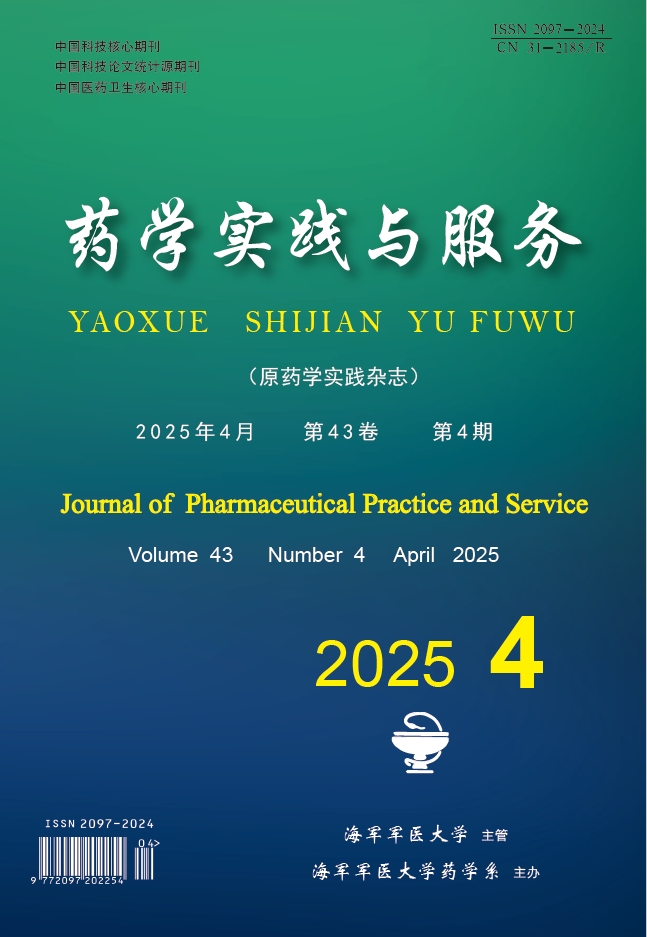2007 Vol. 25, No. 3
Display Method:
2007, (3): 143-144,149.
Abstract:
Objective:To study the LDL oxidation in hypercholesteremia rats and the effects of atorvastatin.Methods:The experimental model of hypercholesteremia was established in rats by ig. fat emulsion. 30 wistar rats were sub-divided randomly into the contro...
Objective:To study the LDL oxidation in hypercholesteremia rats and the effects of atorvastatin.Methods:The experimental model of hypercholesteremia was established in rats by ig. fat emulsion. 30 wistar rats were sub-divided randomly into the contro...
2007, (3): 145-146.
Abstract:
Objective:To find good route of synthesizing methano[C60]fullerene carboxylic acid by using bromoactate for preparing some valuable fullerene derivatives.Methods:Using bromoactate as starting material, ylide was prepared. Ylide and fullerene were use...
Objective:To find good route of synthesizing methano[C60]fullerene carboxylic acid by using bromoactate for preparing some valuable fullerene derivatives.Methods:Using bromoactate as starting material, ylide was prepared. Ylide and fullerene were use...
2007, (3): 147-149.
Abstract:
Objective:To study the protective effects of Danning tablet on CCl4 and D-galactosamine induced liver injury in mice and rats.Methods:Mice and rats were induced acute and chronic liver injury by administrated with D-galactosamine and CCl4 respectivel...
Objective:To study the protective effects of Danning tablet on CCl4 and D-galactosamine induced liver injury in mice and rats.Methods:Mice and rats were induced acute and chronic liver injury by administrated with D-galactosamine and CCl4 respectivel...
2007, (3): 150-151,183.
Abstract:
Objective: To study the chemical components from dried leaves of Typha angustifolia L. and to find out the active constituents of the plant. Methods: Modern chromatography was used to isolate chemical components and the compounds isolated from Typha ...
Objective: To study the chemical components from dried leaves of Typha angustifolia L. and to find out the active constituents of the plant. Methods: Modern chromatography was used to isolate chemical components and the compounds isolated from Typha ...
2007, (3): 154-156.
Abstract:
Objective:To confirm the preparative technology of diltiazem hydrochloride for injection and the effect factor of stability. Methods:HPLC method was used for the determination of content and related substances of diltiazem hydrochloride, and study of...
Objective:To confirm the preparative technology of diltiazem hydrochloride for injection and the effect factor of stability. Methods:HPLC method was used for the determination of content and related substances of diltiazem hydrochloride, and study of...
2007, (3): 159-161.
Abstract:
Objective:To establish a reversed-phase high performance liquid chromatography method for rotenone in Derris elliptica.Methods:The determination was performed on ZORBAX Eclipse XDB-C18 (5 μm,4.6×150 mm)column. The mobile phase consisted of acetonitri...
Objective:To establish a reversed-phase high performance liquid chromatography method for rotenone in Derris elliptica.Methods:The determination was performed on ZORBAX Eclipse XDB-C18 (5 μm,4.6×150 mm)column. The mobile phase consisted of acetonitri...
2007, (3): 162-164.
Abstract:
Objective: To establish nonaqueous RP-HPLC to determine retinol palmitate、colecalciferol and vitamin E acetate in multi-vitamin injection simultaneously. Methods: The fat vitamins were extracted by SPE; The determination was performed on Warters C18 ...
Objective: To establish nonaqueous RP-HPLC to determine retinol palmitate、colecalciferol and vitamin E acetate in multi-vitamin injection simultaneously. Methods: The fat vitamins were extracted by SPE; The determination was performed on Warters C18 ...
2007, (3): 170-173.
Abstract:
Objective: To demonstrate a new concept of hospital pharmacy information system. Methods: By looking into the development history of hospital information system and the demands of an Internet era and incorporating changes in hospital pharmacy and its...
Objective: To demonstrate a new concept of hospital pharmacy information system. Methods: By looking into the development history of hospital information system and the demands of an Internet era and incorporating changes in hospital pharmacy and its...
2007, (3): 181-183.
Abstract:
Objective:To evaluate the clinical use of vancomycins in our hospital.Methods:The retrospective survey on vancomycins in 237 inpatiens (253 prescriptions!) in 2005 was conducted according to The guiding principle of clinical use of antibacterials.Res...
Objective:To evaluate the clinical use of vancomycins in our hospital.Methods:The retrospective survey on vancomycins in 237 inpatiens (253 prescriptions!) in 2005 was conducted according to The guiding principle of clinical use of antibacterials.Res...




 Contribution System
Contribution System Author Login
Author Login Review Login
Review Login Editor Login
Editor Login Reader Login
Reader Login



 News
News